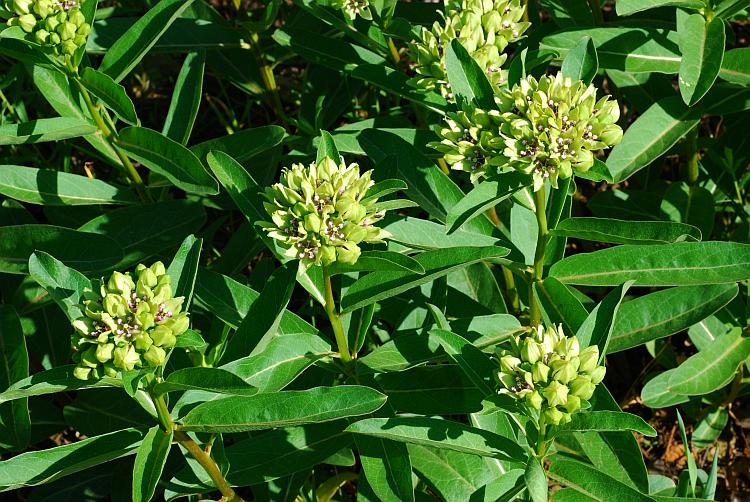Asclepias viridis Walter
Spider Milkweed

Native
CC = 5
CW = 5
MOC = 47
© SRTurner
Asclepias viridis WalterSpider Milkweed | |
 |
Native CC = 5 CW = 5 MOC = 47 |
© SRTurner |
|
Family - Asclepiadaceae Habit - Perennial forb from thickened, tuberous rootstock. Stems - Ascending to spreading, to 60 cm, multiple from base, sometimes few-branched toward the tip, glabrous or sparsely short-hairy toward the tip, often purplish, with milky sap, with 12 to numerous nodes. Leaves - Mostly alternate, simple, sessile or short-petiolate. Petioles to 6 mm long, minutely pubescent. Blades 2-12 cm long, 1-6 cm wide, narrowly to broadly oblong, elliptic-lanceolate, or ovate, the base rounded or truncate, sometimes shallowly cordate, the tip bluntly pointed, the margins flat, glabrous or sparsely and minutely hairy along the midvein. Veins often pinkish above.
Inflorescences - Axillary and terminal umbels, short-stalked, 1-5 per stem. Peduncles glabrous, green, to 5 cm long. Pedicels to 3 cm long, minutely hairy, subtended by linear bracts to 6 mm long.
Flowers - Calyx lobes 5, spreading, glabrous or sparsely and minutely hairy, 3-5 mm long, lanceolate to narrowly ovate. Corolla lobes 5, ascending to spreading, glabrous, pale green to green, 10-17 mm long, elliptic-lanceolate to ovate. Gynostegium appearing sessile (the corona base touching the corolla or nearly so), pale purple to purple, the corona noticeably shorter than the tip of the anther/stigma head. Corona hoods purple, 4-6 mm long, deflexed in the basal 1/3-1/2, with curved, ascending tips, attached in the deflexed portion, the ascending portion narrowly club-shaped, the tips hoodlike, the margins not toothed, the bases not pouched. Horns absent (reduced to a small, platelike appendage near the tip of the inner surface of the hoods). Anther head 3 mm in diameter, 3 mm tall, blackish and green. Pollinia purple and gold, 2-3 mm long. Carpels 2, 3.5 mm long, enclosed by column.
Fruits - Follicles 6-13 cm long, erect or ascending from usually deflexed stalks, broadly lanceolate to ovoid in outline, the surface smooth, glabrous or more commonly minutely hairy. Seeds with the body 7-8 mm long, broadly ovate, the margins narrowly winged, the terminal tuft of hairs to 4 cm long, white to light cream-colored.
Flowering - May - June. Habitat - Upland prairies and glades, usually on calcareous substrate, fields, roadsides. Origin - Native to the U.S. Lookalikes - None. Other info. - In Missouri this plant is found mainly in counties south of the Missouri River. Its U.S. range mainly comprises the lower Midwest and southern states. It is easily recognized by its bushy habit, which is unlike most other milkweeds, and the spreading purple hoods inside of greenish corollas. In some areas it is quite common along roadsides. Photographs taken off Blue Parkway Drive, Jackson County, MO., 7-2-00, in the Ozark National Scenic Riverways, Shannon County, MO., 5-20-03, and at Devil's Well, MO., 6-27-03 (DETenaglia); also at Shaw Nature Reserve, Franklin County, MO, 5-13-2007, 5-19-2009, and 6-30-2023, Victoria Glade, Jefferson County, MO, 5-30-2009, and Don Robinson State Park, Jefferson County, MO, 6-20-2023 (SRTurner). |